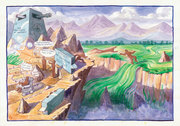In recent years I have also discovered that there are some great resources on YouTube that we can use to gain insights into how an individual's creativity works - in a particular context. For example,
I have become a fan of Christopher Nolan (who has directed films like Intersteller, Inception, Dark Knight and many more). He features in many clips talking about the way his films are made. What hits you is the intelligence he brings to his projects, the commitment and effort he puts in to finding more than one right answer, his willingness to trust the people he works with to experiment and to persevere. All these things are necessary to achieve the complex creative product which is the film.
| There is an interview in which Christopher Nolan (great film director) talks about what he did to engage Hans Zimmer (great music composer) into writing the main theme for the movie Intersteller, tricking him to think he was writing for one relational situation when he was writing for another. Then Hans Zimmer talks about his relationship with Roger Sayer the wonderful musician who played the organ for the main theme and how working together and bouncing ideas and judgements off each other and how the musician influenced the composer and vice versa through this process. Clearly the context for where good ideas and these individuals' creativity flows from is, in part, in the respectful relationships and interactions of these talented musicians. Ideas are played with, re-shaped and co-created through lived experiences involving demonstration, listening, writing, performing and recording. These are the types of energetic collaborations that cause ideas and emotions to collide and produce something truly original. | I think we can learn a lot from film making about creative processes. There is a lot of working through what is possible and what is not possible and discovering novelty in the process. From an imagineering perspective I get inspired by hearing stories about people working together to produce something significant and I wonder whether we might do more to inspire students in the same way (in disciplinary, interdisciplinary and trans-disciplinary contexts). But they also need to experience learning and performance environments that are challenging, emotionally as well as intellectually engaging, deeply collaborative and facilitative. |
| | Award winning photographer Dewitt Jones (DJ) illustrates the wisdom in this proposition when he talks about putting himself into situations with the greatest potential for getting what he calls 'possible right answers.' Jones teaches me that creativity emerges from a complex ecology in which the person interacts with their environment in a continuously unfolding present. |

The wisdom in DJ's story of personal creativity is in the way he reveals that we not only need the cognitive and technical abilities to fulfil a goal, we also need to understand the physical and social environment in which the problem, challenge or opportunity is embedded. Only when we understand the environment we are working in, and formed the necessary relationships with the resources in it, can we discover and create possible right answers. Furthermore, he shows us that we should not be satisfied with one possible right answer that is good enough but carry on searching for more possibilities. Neither should we be overly worried about making mistakes as mistake making is a necessary pathway to finding more than one right answer.
The idea that creativity emerges through an ecology involving ourselves, our environment and the problems, challenges and opportunities we are working with fits very well the ecological concept of creativity proposed by Carl Rogers, 'the emergence in action of a novel relational product , growing out of the uniqueness of the individual on the one hand, and the materials, events, people, or circumstances of his life on the other' (Rogers 1961:350).
I think higher education struggles to create learning environments, cultures and rules that permit and encourage the sort of responses that Dewitt Jones describes. I have thought for some time that students themselves are better at finding these sorts of circumstances in their own lives outside formal study and the issue then becomes how can higher education with concerns for learning and achievement, recognise students' creativity. Perhaps we stand a chance of achieving this if universities
embraced the idea of learning ecologies and saw learners' as the creators of their own ecologies for learning and achieving, rather than only seeing students' development as the product of ecologies which universities create.
TO READ THE POSTS IN THE #CREATIVEHE IMAGINEERING CONVERSATION VISIT
https://plus.google.com/communities/106367720977059375674
Sources of ideas
Jackson, N J (2016) Exploring Learning Ecologies Lulu
https://www.lulu.com/shop/search.ep?keyWords=exploring+learning+ecologies&type=
Rogers, C.R., (1961) On becoming a person. Boston: Houghton Mifflin
Zander, Rosamund, Zander, Ben (2000) The Art of Possibility: Transforming Professional and Personal Life Harvard Business School Press




 RSS Feed
RSS Feed